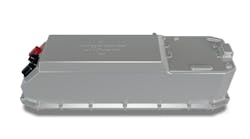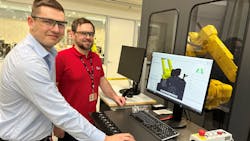With this week's news we saw the introduction of new battery technology from Briggs & Stratton, demonstrating the continued growth of electrification and related technologies. The company introduced its first battery pack for off-highway applications in 2019; since then it has added more models with increasingly higher power capabilities to expand the range of applications in which the batteries can be used.
Robots are another area seeing growth in recent years as shown by Danfoss Power Solutions announcing its addition of a 3D scanner robot to its manufacturing operations for joysticks. The robot is helping improve and speed up the quality inspection process, leading to an overall improvement in production time. With the process improvement benefits robots continue to demonstrate, their uptake in various applications is expected to rise over the coming years.
This week, the National Fluid Power Association (NFPA) announced the finalized speaker lineup for its upcoming Industry & Economic Outlook Conference. During the annual event, economists and industry experts will highlight the latest market data and trends to help fluid power manufacturers navigate their business in the coming year.
There is much going on in the world of fluid power and motion control, from technology introductions and industry advancements to new trends and industry leaders. Each week the Power & Motion team collects some of the latest industry news to help keep our readers up to date on what's happening in the industries in which they work.
Danfoss Uses 3D Scanner Robot to Improve Product Quality
Danfoss Power Solutions' facility in Nordborg has added a 3D scanner robot to its joystick manufacturing lines. The robot is able to measure component dimensions to the micron level which helps improve quality inspections and end-product results for customers.
With the robot, Danfoss personnel can quickly determine if joystick components meet required specifications. This helps to speed up the production process and eliminate the need to outsource the quality check to a third party. Time and cost savings are possible, as well as the ability to have greater in-house control over the manufacturing process said Danfoss in its press release announcing the addition of the robot.
As Danfoss explained in its press release, the robot uses narrow-band blue light to measure up to 12 million points on the component surface within a few seconds, subsequently creating a 3D image which is compared to the original CAD file. Complex shapes and forms can be scanned with a high level of accuracy, enabling the company to ensure the quality of the various joysticks it produces.
According to Abel Dukai, mechanical engineer in Danfoss' Connect & Controls Solutions business unit in Nordborg, who is co-leading the 3D scanner project, micron-level precision down to 0.007 mm is provided by the robot.
"The scanner is so fast and easy to use that we can literally verify component dimensions while we manufacture, which is not possible with CMM (coordinate measuring machine) technology," stated Dukai in Danfoss' press release. "We now know immediately whether part dimensions are 100% identical to the computer-generated design files, so the 3D scanner has taken our quality testing capability to a new level."
READ MORE: Danfoss Partnership Yields First Completely Joystick-Operated Combine in Europe
igus Launches Service Life Calculator Tool for Hybrid Roller Bearings
igus has announced the release of a service life calculator tool for its WJRM hybrid roller bearings. This bearing line brings together features of the company's drylin linear bearing technology with that of ball bearings as a means of reducing friction in a variety of applications.
In addition to calculating service life of the WJRM bearings, the new calculator tool can provide details on drive force for the bearings as well as pricing. With this digital tool, customers will be better able to determine the lifespan of the WJM bearings in their applications and plan maintenance to reduce unplanned downtime.
DOE Announces Funding Intent for Hydrogen Technologies
The U.S. Dept. of Energy (DOE) has issued a notice of intent specifying potential funding to aid research and development of clean-hydrogen and related grid technologies. President Biden has made the climate a priority, and this funding would help to meet the goals set out by the administration which include the U.S. achieving carbon-free electricity by 2035 and net-zero carbon emissions by 2050.
With this new funding, the DOE aims to reduce the cost of producing clean hydrogen in order to make it a more sustainable fuel option as well as improve its affordability.
Per the DOE's press release announcing the funding intent, areas of focus will include:
- advanced pathways for solar-based hydrogen fuel production;
- technologies for high-resolution hydrogen sensing;
- demonstrations of materials-based hydrogen storage and transport systems;
- and development of high-performance, durable, low-cost fuel cell components for medium- and heavy-duty vehicles.
Grid capabilities will be a focus as well. The DOE intends to establish a grid resilience university consortium with agreements between universities in the United States, Canada, and Mexico to foster information sharing on best practices and cross-border dependencies it stated in its press release. Collaboration through this consortium will work to make the grid more stable and create models which can benefit various applications, communities and regions.
Several financial assistance awards are expected through this funding for R&D efforts over a 2-4 year basis. The DOE is encouraging those from industry, academia and national laboratories to participate.
Briggs & Stratton Introduces New Battery
Briggs & Stratton is expanding its battery lineup with the addition of the new Vanguard 7kWh Diecast Commercial Battery. The battery can be used in more applications such as turf equipment, golf and recreational vehicles.
Built on the design of its 3.8 kWh Commercial Battery, the new Diecast Commercial Battery features Cellular Module Assembly units packed into a diecast aluminum casing which provides durability and protection from extreme temperatures. A Lithium-ion chemistry is utilized to ensure reliable performance the company stated in its press release announcing the launch of the new battery.
The battery can used in conjunction with additional battery packs to meet the higher power needs of larger applications.
Komatsu Trialing Electric-Powered Mining Tunnel Boring Machine
Komatsu is working with mining company Codelco to trial a new tunnel excavation method using a newly designed Mining Tunnel Boring Machine (TBM) from Komatsu.
The machine features several new technologies to aid its use in deep, underground mining environments which are becoming increasingly more common to reach the materials desired for various products, such as electric vehicle batteries. New technologies in the TBM enable it to more easily adapt to small curves, reverse and pass intersections. This is an improvement over previous machines which were usually limited to use in nearly straight tunnels.
Komatsu's new TBM is powered by electricity, helping to make the excavation process safer and more sustainable by reducing emissions output. It is also able to complete various tunnel operations without the need for blasting, enabling a single machine to conduct various tasks, further reducing emissions and operational costs for customers.
Komatsu and Codelco are scheduled to begin testing the new machine and excavation methods in 2024 at Coldelco's Chuquicamata Mine in Chile.





